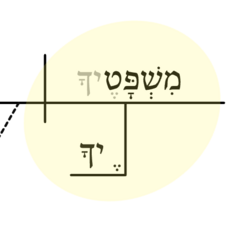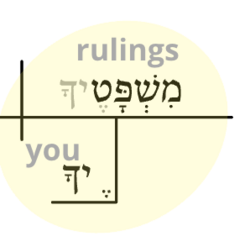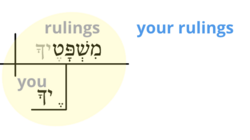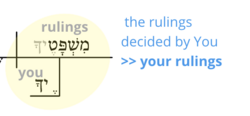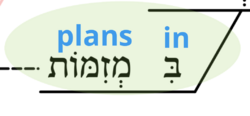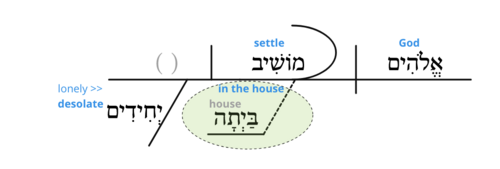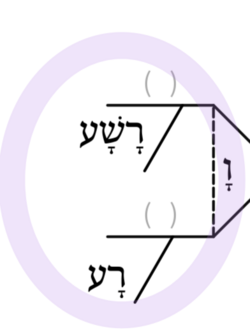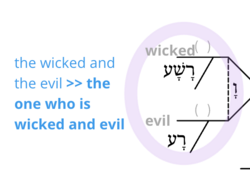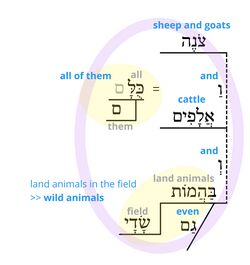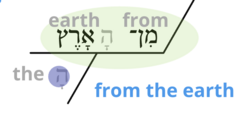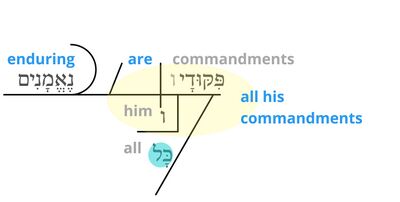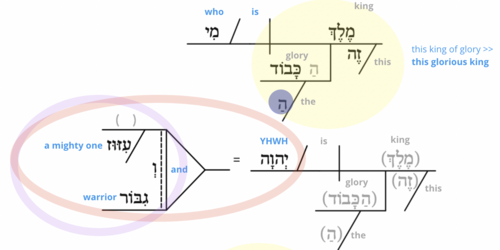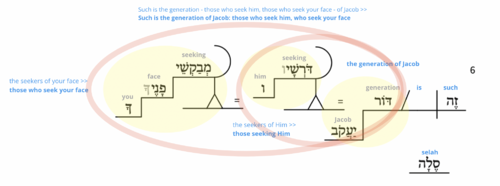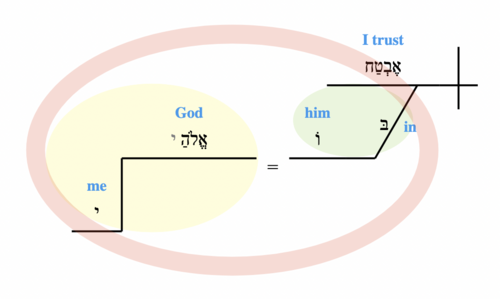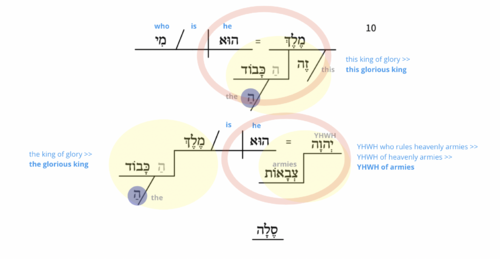Method:Phrase-Level Semantics
- Grammar
- Semantics
- Exegetical Issues
- Discourse
- Poetics
- Synthesis
- Close-but-Clear
- Videos
- Post to wiki
- Style Guide
Overseer: Ian Atkinson
Introduction
The purpose of Phrase-Level Semantics is to analyse the meaning of units that are higher than the level of the word (Method:Semantics/Lexical Semantics) and lower than the level of the sentence (Semantics/Story behind the Psalm). Specifically, this layer seeks to answer the following questions:
- What is the relationship between each member of a construct phrase?
- What is the function of each preposition?
- What does the definite article or כֹּל tell you about the word to which it is attached?
- What is the semantic role of each constituent in each sentence?
Steps
1. Set up your workspace.
- Copy and paste the phrase-level-semantics template into your workspace.
- Replace the grammatical diagram in the template with the grammatical diagram for your psalm.
2. Construct phrases
Hebrew has a grammatical means of encoding ‘A of B’; this construction can express many different relationships between two (or more) nouns. English grammarians call this construction a ‘Construct’ (our term) or ‘Genitive’ phrase; Hebrew grammarians call it smīḵūt (סְמִיכוּת).
A. Identify and circle construct phrases.
Construct phrases on the grammatical diagram look like stair steps. Overlay all construct phrases (stair steps) on the grammatical diagram with yellow circles. To do this, you can copy the yellow circle that is in the legend and paste it onto the diagram, resizing and rotating it as necessary. See the picture below for an example of a construct phrase in Ps. 10:5.
B. Gloss construct phrases.
The grammatical diagram should already be glossed with the glosses chosen in lexical semantics. For example, מִשְׁפָּטֶי should be glossed "rulings" and ךָ should be glossed "you." Change the colour of these glosses from blue to grey (colour: #AAAAAA; size 18).
Next, gloss the entire phrase using bold blue font (colour: #2D9BF0; size 18). As you analyze the phrase, consult the list of construct relationships provided in Appendix A. (If, however, the phrase-level gloss would be identical to the sum of the word-level glosses, then do not grey out the word-level glosses and add a phrasal gloss. Instead, leave the word-level glosses blue.)
In some instances, this would be the final step. In others, however, the ‘English translation’ does not (indeed, cannot) adequately capture the semantics of the phrase. This is the case here. It is not clear from ‘your rulings’ that ‘those rulings that come from you’ is meant and not, say, ‘the rulings owned by you’ or something. When this happens, write out a fuller expression of the semantics of the phrase; this will usually be similar to or exactly the same as what you wrote in the chart's ‘semantic analysis’ column. Make sure this fuller description is in non-bold blue font (colour: #2D9BF0; size 18) followed by two right-pointing arrows ‘>>’.
These arrows will be necessary any time it is not immediately clear how one gets from the phrase as it stands in the Hebrew to the meaning reflected in your English translation. The arrows represent the 'steps' you took to get there.
C. Take notes.
Take notes about difficult issues pertaining to the phrase and document where you found the answer. Format your notes as text-boxes next to the diagram. In your notes, interact with other interpretations of the phrase found in modern Bible translations, Hebrew grammars, commentaries, etc.
3. Prepositional Phrases
On the grammatical diagram, prepositional phrases usually (1) sit on a horizontal line connected to a diagonal line and (2) consist of the preposition and its object on the same line separated by a space. For example,
A. Identify and circle prepositional phrases.
As with construct phrases, copy/paste, drag and drop the appropriate circle over a given prepositional phrase. Let's use a phrase from Psalm 10:2 as our example
Use the green shaded circle in the legend for prepositional phrases.
B. Gloss prepositional phrases.
As with construct phrases, provide a gloss for each prepositional phrase. If your English translation/gloss of the phrase is equivalent to sum of the glosses provided at the lexical level, then there is no need to change the glosses from blue to grey and add an additional gloss. In this case, leave the bold blue font over the Hebrew as shown in the above image. When, however, your gloss of the prepositional phrase differs from the sum of the lexical glosses of the diagram, make the lexical glosses grey (colour: #AAAAAA) and add a new phrase-level gloss in blue.
As you analyze the phrases, consult the resources suggested in Appendix B. For this specific construction in Ps. 10:2, the בְּ preposition probably indicates "location" in a figurative sense. In other words, the preposition is marking the location where the action of the verb (יתפשו 'may they be caught') is to take place, so בְּ = 'in' here, used figuratively.
C. Take notes.
Take notes next to the diagram for any difficult phrases. Make sure to cite any sources consulted.
D. Include adverbial accusatives.
Adverbial accusatives should also be analyzed at this point in the analysis. Adverbial accusatives are nouns or noun-phrases which function adverbially. They are similar, in this respect, to prepositional phrases. Adverbial accusatives are diagramed just like prepositional phrases, except the slanted line is dashed instead of solid. Adverbial accusatives are also marked, at this layer, in a manner similar to prepositions; they are marked with a green circle, though the green circle has a dashed border.
See the list of possible functions in IBHS 10.2.2.
Note: Combined Construct and Prepositional Phrases
When a construct phrase appears within a prepositional phrase, use a yellow circle with a green border. See the following example from Psalm 110:1.
4. Phrase-Level Waw and Hendiadys
The conjunction waw (וְ) can join units of all sizes (e.g., words, phrases, clauses, paragraphs). At this layer, we are focused only on those waw's which join words and phrases to form (larger) phrases.
A. Identify and circle all phrase-Level waw's and their members
Here is an example of a phrase-level waw from Psalm 10:15
B. Gloss words coordinated by phrase-level waw.
See, for example, the waw phrase in Ps. 10:15.
The phrase refers '(the) wicked (person) and (the) evil (person)' is not meant to refer to two different people but to two different characteristics of a single person ('the one who is wicked and evil'). The arrows '>>' are used here to bring this out clearly.
In cases in which a phrase-level gloss for the waw phrase would not differ from the glosses provided at the lexical level, it is not necessary to provide a gloss for the whole phrase; the lexical glosses will suffice. For example,
Such pairs may also include a participle or similarly verbal idea, in which case a separate gloss should be provided for the entire phrase.
Such an approach also applies to verbal hendiadys, even in the absence of waw. Since two adjacent clausal constituents can communicate one idea, this should also be treated here.
C. Take notes.
Take notes next to the diagram for any difficult phrases. Make sure to cite any sources consulted.
5. Articles and כֹּל
Definite articles give information about the identifiability or the inclusiveness of the word to which the article is attached. כֹּל is a quantifier that gives information about the scope of the word to which it is attached.
Identify and mark all articles and instances of כֹּל
Go through the grammatical diagram and mark every instance of the article and כל with the appropriate colours (see legend). Note: do not highlight all definite words (e.g. proper names, nouns with pronominal suffixes), only the definite article.
B. Gloss all articles and instances of כֹּל.
See the following examples:
Use Appendix C to determine the functions of the article as well as the functions of כֹּל.
C. Take notes.
Take notes next to the diagram for any difficult phrases. Make sure to cite any sources consulted.
6. Apposition
When two clausal constituents are co-referential, we have nominal apposition, such as King David or David, the king.[1] Ideally, they would be two noun phrases having the same syntactic function, so that the sentence would still be valid with the omission of either one or the other. However, theoretical discussion surrounding apposition has questioned this requirement (see Crystal's comment in the footnote), so in our treatment of apposition we will include any instance of the "equals sign" in the diagram, neither limiting ourselves strictly to noun phrases, linear adjacency, nor syntactic equivalence. Thus, besides the obvious cases of two adjacent noun phrases with identical syntactic roles:
our treatment of apposition will include vocatives:
as well as cases of left-dislocation and/or extraposition:
In summary, we are primarily concerned with semantic co-referentiality and the relationship between the two construals of the same constituent. We will therefore be following BHRG's semantic categories of nominal apposition (for which, see Appendix E).
Additional Resources
- Gesenius, W. 1909. Hebrew Grammar. Edited by E. Kautzsch. Translated by A.E. Cowley. 28th (German) 2nd (English). Oxford: Claredon Press.
- Jenni, Ernst. 1992. Die Hebräischen Präpositionen Band 1: Die Präposition Beth. Stuttgart: W. Kohlhammer.
- Jenni, Ernst. 1994. Die Hebräischen Präpositionen Band 2: Die Präposition Kaph. Stuttgart: W. Kohlhammer.
- Jenni, Ernst. 2000. Die Hebräischen Präpositionen Band 3: Die Präposition Lamed. Stuttgart: W. Kohlhammer.
- Joüon, Paul S.J., and S.J. Muraoka. 2006. A Grammar of Biblical Hebrew. Subsidia Biblica 27. Rome: Editrice Pontifico Instituto Biblico.
- Merwe, Christo H.J. van der, Jacobus A. Naudé, and Jan H. Kroeze. 2017. A Biblical Hebrew Reference Grammar. 2nd ed. New York: Bloomsbury.
- Waltke, Bruce K., and M. O’Connor. 1990. An Introduction to Biblical Hebrew Syntax. Winona Lake, Indiana: Eisenbrauns.
Rubric
| Dimension | Description |
|---|---|
| Completeness | The page includes every element required by the creator guidelines.
|
| Quality of Analysis |
|
| Engagement with secondary literature |
|
| Clarity of language |
|
| Formatting/Style |
|
Submitting your draft
Copy this text into your forum submission post, entitled Phrase-Level Semantics- Psalm 999:
[Phrase-Level Semantics Layer Rubric](https://psalms.scriptura.world/w/Phrase-Level_Semantics#Rubric) |Guardian Review|Overseer Review|Final Checks|Description| | --- | --- | --- | --- | |||| **Completeness** |||| The page includes every element required by the creator guidelines. |||| *Complete diagram* |[ ]||| Construct phrases marked and glossed. |[ ]||| Prepositional phrases marked and glossed. |[ ]||| *Waw* phrases marked and glossed. |[ ]||| Appositional phrases marked and glossed. |[ ]||| Definite articles marked. |[ ]||| Quantifiers marked. |||| **Quality of Analysis** |[ ]|[ ]|[ ]| In the case of difficulties and alternatives, each view is thoroughly explained and defended with a note. |[ ]|[ ]|[ ]| Preferred views are well grounded in evidence. |||| **Engagement with secondary literature** |[ ]|[ ]|| Effort was made to consult grammars, commentaries, articles and other reference sources (e.g., Jenni) for difficult phrases. |[ ]|[ ]|[ ]| Notes are well-researched and citations are properly documented. |||| **Clarity of language** |[ ]|[ ]|[ ]| Prose (within notes) is clear and concise. |[ ]|[ ]|[ ]| Language is not too technical so as to be inaccessible to [Sarah](https://psalms.cdbr.org/w/Personas). If a technical concept is unavoidable, it must be clearly explained. |||| **Formatting/Style** |[ ]|[ ]|| Phrasal glosses and symbols are properly encoded in the diagrammer. |[ ]|[ ]|| All sources are properly cited (see Style guide). |[ ]|[ ]|| Notes are free of typos. |[ ]|[ ]|[ ]| Double arrows (>>) are used to separate literal from figurative phrasal glosses as well as language that needs to changed in any way.|
Appendices
Appendix A: Construct Relations
The following list is taken from section §25.4 of van der Merwe et al. (2017, 226–229). You should be able to find all you need here. If not, the relevant sections in the other grammars are: Gesenius §89a, §128g–y; Joüon & Muraoka §129; Waltke & O’Conner §9.4–§9.5
Relationships of Possession
- (1) Possession (concrete object)–possessor
- The house of the king בֵּית הַמֶּלֶךְ
- (2) Possession (body part)–possessor
- The lips of the king שִׂפְתֵי המֶּלֶךְ
- (3) Possession (characteristic)–possessor
- The majesty of the king הַדְרַת־המֶּלֶךְ
- (4) Kinship/relationship–possessor
- The sons of the king בְּנֵי המֶּלֶךְ
- (5) Possessor–possession
- The owner of the house בְּעַל הַבַּיִת
Subject and Object Relations
- (1) Verbal notion–subject
- The blessing of (or, by) the Lord בִּרְכַּת יהוה
- (2) Verbal notion (passive)–agent
- The murdered (ones) of the woman הֲרוּגֵי הָאִשָּׁה
- (3) Verbal notion–object
- The fear of (for) the Lord יִרְאָת יהוה
Partitive Relationships
- (1) Part–divided whole
- The members of (among) the prophet guild בְּנֵי הַנְּבִיאִים
- (2) Superlative part–divided whole
- The best (good) of (among) the sons טוֹב הַבָּנִים
- (3) Specification of undivided whole
- All of the sons כָּל־הַבָּנִים
Equalising Relationships
- (1) Entity–synonym
- Joy of (viz.) rejoicing שִׂמְחַת גִּיל
- (2) Entity–class (genus)
- A fool of (viz.) a person כְּסִיל אָדָם
- (3) Entity–type (species)
- Sacrifices of (viz.) peace offerings זִבְחֵי שְׁלָמִים
- (4) Entity–name
- The river of (viz.) the Euphrates נְהַר פְרָת
- (5) Entity–characteristic (description, attribute, quality)
- Words of (with) insight אִמְרֵי בִינָה
Adverbial Relationships
- (1) Entity–aim, goal or result
- Stones of (meant for) a sling אַבְנֵי־קֶלַע
- (2) Entity–manner
- Riches of (acquired through) injustice אוֹצְרוֹת רֶשַׁע
- (3) Entity–cause or reason
- Exhausted (ones) of (due to) hunger מְזֵי רָעָה
- (4) Entity–means (instrument)
- The wounded (ones) of (by means of) the sword חַלְלֵי־הַחֶרֶב
- (5) Entity–duration of time
- A son of a year בֶּן־שָׁנָה
- (6) Entity–direction
- The (ones) going down (into the) pit יוֹרְדֵי בוֹר
- (7) Entity–origin
- The loot of (from) the cities שְׁלַל הֶעָרִים
Other Relationships
- (1) Product–material
- Vessels of silver כְּלֵי כֶסֶף
- (2) Product–author, creator, source, origin
- The book of (by) the man סֶפֶר הָאִישׁ
- (3) Characteristic–with regard/respect to (specification)
- Foolish of (with respect to) lips אֱוִיל שְׂפָתַיִם
- (4) Entity–interested (favoured/injured) party
- The trap of (for, to the detriment of) a person מוֹקֵשׁ הָאָדָם
- (5) Container–content
- A bag of (full of) water חֵמַת מַיִם
Appendix B: Prepositions
A comprehensive list would be too big for these guidelines. We recommend that you consult one of the following grammars: Gesenius §119g–§119ii; Waltke & O’ Conner §11.2–§11.3; Joüon & Muraoka §133; van der Merwe et. al. §39.2–§39.22. The last of these is probably the most user-friendly. A word is in order, however, about the possibly difficult terminology employed by this grammar.[2]
Appendix C: Determiners
Functions of the Definite Article
The following list is taken from van der Merwe et al. §24.4.4 unless otherwise noted. If none of these common functions fit, have a look at the following sections: Gesenius §126; Waltke & O’Conner §13.5.1–§13.5.2; Joüon & Muraoka §137f–§137n.
Note that 1–4 are known as the ‘semantic’ uses of the article (the article tells us something about the referent of the word to which it is attached), while 5–8 are ‘syntactic’ uses (the article combines with a noun in order to fill a particular role in the sentence). For the purposes of this visualisation, this distinction does not really matter, but it’s good to be aware.
| Use | Explanation | Example | Comment |
|---|---|---|---|
| Identifiability - unique referent | The article is often used because the thing it’s attached to is the only one of its kind. | הַשֶּׁמֶשׁ ‘The Sun’ | A speaker may expect the hearer to be able to identify the Sun because there is only one Sun in our world. |
| Identifiability - specific referent | The article is used on nouns that have been previously mentioned in a span of text. | וַיִּקַח…בֶן־הַבָּקָר ‘And he took…the calf’ (Gen 18.8). | The reader can identify the calf in question because it was introduced (without an article) in v. 7. |
| Identifiability - implication | The article can mark entities that we may infer are present in a situation (even if not previously mentioned). | וַתּעַר כַּדָּהּ אֶל־הַשֹּׁקֶת ‘And she emptied the jar into the trough’ (Gen 24.20). | The jar has to be emptied somewhere. That somewhere gets the article. |
| Inclusiveness - Class | The article is used to refer to all members of a certain class. | לֹא תואכְלוּ…אֶת־הַגָּמָל ‘Do not eat camels [lit., the camel]’ (Lev. 11.5). | No specific camel is in view here. Rather, all things that belong to the class ‘camel’. |
| Demonstrative | The article ‘points’ to something, especially time. | הַיוֹם ‘Today’ [lit. ‘the day’] (Gen. 4.14). | |
| Vocative | The article can combine with an addressee in order to express a vocative. | חֵי נַּפְשְׁךָ הַמֶּלֶךְ ‘As surely as you live, O King’ (1 Sam 24.9) | |
| Relative Marker | The article can combine with a word—most commonly a participle—in order to mark the beginning of a relative clause. | לַיהוה הַנִּרְאֶה אֵלָיו ‘To the Lord, who had appeared to him’ (Gen 12.7). | |
| Superlative | The article + predicative adjective is one strategy used in Hebrew for the superlative. | כִּי־אַתֶּם הַמְעַט מִכָּל־הָעַמִּים ‘You are the fewest of all the people’ (Deut. 7.7). |
Functions of כֹּל
The noun כֹּל ‘all’ is used as a quantifier. Quantifiers specify the number of entities that satisfy the referent to which it is attached. The meaning of כֹּל depends on the definiteness and number of the noun to which it is attached. You will generally choose from the following four options, taken from van der Merwe et. al. (2017, 309–310)
With a singular and indefinite noun, כֹּל can be glossed ‘each; every individual’. That is the reference is to each discrete entity within an unidentifiable whole.[3] So in the following example, God feels indignation each individual day for an unspecified length of time.
וְאֵ֗ל זֹעֵ֥ם בְּכָל־יֽוֹם׃
A God who feels indignation each/every day (Psa. 7.12)
With a plural and indefinite noun; כֹּל means ‘all; each and every one’. That is, the reference is to an unidentifiable whole that, of course, is composed of individual items.[4] In the following example, notice that the verb is plural, because the reference is to the many tables that make up the unspecified whole.
כִּי כָּל־שֻׁלְחָנ֔וֹת מָלְא֖וּ קִ֣יא צֹאָ֑ה
All tables are filled with filthy vomit (Isa 28:8).
With a singular and definite noun; כֹּל can be glossed ‘all’. That is, the reference is to every member of an identifiable group. In the following example, Qohelet tells us each member of the group identifiable via common knowledge ‘mankind’ should eat, drink and be merry.
וְגַ֤ם כָּל־הָאָדָם֙ שֶׁיֹּאכַ֣ל וְשָׁתָ֔ה וְרָאָ֥ה ט֖וֹב בְּכָל־עֲמָל֑וֹ
And also all mankind should eat and drink and see good in all of his toil (Eccl. 3:13)
With a plural and definite noun; כֹּל can be glossed ‘all’. That is, the reference is to the totality of an identifiable group. In the following example, we find out the sum total of all the temple servants just listed. The temple servants are identifiable (they have the definite article) because they were previously mentioned in the text (v. 43).
כָּ֨ל־הַנְּתִינִ֔ים וּבְנֵ֖י עַבְדֵ֣י שְׁלֹמֹ֑ה שְׁלֹ֥שׁ מֵא֖וֹת תִּשְׁעִ֥ים וּשְׁנָֽיִם׃
All (the total) of the temple servants and the sons of Solomon’s servants—392 (Ezra 2:58).
Appendix D: Waw
The various functions of phrase-level waw are as follows.[5]
1. Every entity (#a), groups of entities (#b) or only the last entity in the list (#c) to be added, is preceded by וְ. In negated clauses or conditional clauses, a list of “apparent” alternatives may be involved (#d).
| a | כִּ֤י אָֽנֹכִי֙ נָתַ֣תִּי לָ֔הּ הַדָּגָ֖ן וְהַתִּיר֣וֹשׁ וְהַיִּצְהָ֑ר | that it was I who gave her the grain, the wine [lit. and the wine], and the oil (Hos. 2:10) |
| b | נֹתְנֵ֤י לַחְמִי֙ וּמֵימַ֔י צַמְרִ֣י וּפִשְׁתִּ֔י שַׁמְנִ֖י וְשִׁקּוּיָֽי | who give (me) my bread and my water, my wool and my flax, my oil and my drink (Hos. 2:7) |
| c | כָּל־מְשׂוֹשָׂ֔הּ חַגָּ֖הּ חָדְשָׁ֣הּ וְשַׁבַּתָּ֑הּ | all her mirth, her feast(s), her new moon(s) and her sabbath(s) (Hos. 2:13) |
| d | לֹֽ֣א־תַעֲשֶׂ֣֨ה כָל־מְלָאכָ֡֜ה אַתָּ֣ה ׀ וּבִנְךָֽ֣־וּ֠בִתֶּ֗ךָ עַבְדְּךָ֤֨ וַאֲמָֽתְךָ֜֙ וּבְהֶמְתֶּ֔֗ךָ וְגֵרְךָ֖֙ אֲשֶׁ֥֣ר בִּשְׁעָרֶֽ֔יךָ | You shall not do any work, you, or your son, or your daughter, you manservant, or your maidsevant, or your cattle, or the sojourner who is within your gates (Exod. 20:10). |
Sometimes (#e) the phrases to be coordinated by וְ are split (called split coordination).
| e | וְעָבְד֤וּ אֹתוֹ֙ כָּל־הַגּוֹיִ֔ם וְאֶת־בְּנ֖וֹ וְאֶֽת־בֶּן־בְּנ֑וֹ | And they shall serve him, all the nations, and his son and the son of his son (Jer. 27:7). |
Sometimes (#f) two words form a type of fixed compound. (If the word that is preceded by וְ is short then וָ is used instead of וְ.)
| f | ט֣וֹב וָרָ֔ע | good and evil (Gen. 2:17) |
2. Sometimes both the first and the second entity of a coordinated phrase are preceded by וְ. It is then regarded as a correlative conjunction.
| וּבְיִשְׂרָאֵ֖ל וּבָֽאָדָ֑ם | both in Israel and among all humankind (Jer. 32:20). |
3. An apparently superfluous use of וְ (rare).
| וַתֵּ֤שֶׁב תָּמָר֙ וְשֹׁ֣מֵמָ֔ה בֵּ֖ית אַבְשָׁל֥וֹם אָחִֽיהָ׃ | So Tamar, [lit. and] a desolate woman, dwelt in the house of Absalom, her brother (2 Sam. 13:20). |
Appendix E: Nouns in Apposition
The second member of the phrase elucidates the first in one of the following ways:[6]
- (1) The second member designates the role/capacity of the first member.
- שָׂרָ֥ה אִשְׁתּ֖וֹ Sarah, his wife (Gen. 20:2) ָ
- (2) The second member specifies the status of the first member.
- אִשָּׁה֩ אַלְמָנָ֨ה a woman, a widow (1 Kgs 7:14)
- (3) The second member reveals a characteristic/quality of the first member.
- אֲמָרִ֥ים אֱ֝מֶ֗ת words, truth (i.e. true words) (Prov. 22:21)
- (4) The second member specifies the material from which the first member is made.
- הַבָּקָ֥ר הַנְּחֹ֖שֶׁת the cattle, the bronze (i.e. the cattle made of bronze) (2 Kgs 16:17)
- (5) The second member specifies the substance, a measuring unit or number of the first member.
- סְאָֽה־סֹ֣לֶת ... וְסָאתַ֧יִם שְׂעֹרִ֛ים and a measure of fine meal... and two measures of barley (2 Kgs 7:1)
- (6) The second member specifies the pronominal reference of the first member.
- וַתִּרְאֵ֣הוּ אֶת־הַיֶּ֔לֶד And she saw him, the child (Exod. 2:6)
Appendix F: Semantic roles
The following list and definitions are from Paul Kroeger, Analyzing Grammar, 2005, chapter 4.
- Agent: causer or initiator of events
- Experiencer: animate entity which perceivers a stimulus or registers a particular mental or emotional process or state
- Recipient: animate entity which receives or acquires something
- Beneficiary: entity (usually animate) for whose benefit an action is performed
- Instrument: inanimate entity used by an agent to perform some action
- Theme: entity which undergoes a change of location of possession, or whose location is being specified
- Patient: entity which is acted upon, affected, or created; or of which a state or change of state is predicated
- Stimulus: object of perception, cognition, or emotion; entity which is seen, heard, known, loved, remembered, hated, etc.
- Location: spatial reference point of the event
- Source: the origin or beginning point of a motion
- Goal: the destination of end-point of a motion
References
- ↑ Matthews' definition of apposition is as follows: "A syntactic relation in which an element is juxtaposed to another element of the same kind. Especially between noun phrases that do not have distinct referents: e.g. Lucienne is in apposition to my wife in Do you know my wife Lucienne? Thence of other cases where elements are seen as parallel but do not have distinct roles in a larger construction: e.g. Smith is seen as apposed to Captain in Do you know Captain Smith? https://www-oxfordreference-com.ezp.lib.cam.ac.uk/display/10.1093/acref/9780199202720.001.0001/acref-9780199202720-e-211?rskey=x4Lms1&result=211. SIL's Glossary provides the following definition: "An apposition is a construction consisting of two or more adjacent units that have identical referents" and examples: My friend John and This excuse, that you didn’t get the word, is a poor one. https://glossary.sil.org/term/apposition. Crystal is more nuanced: "A traditional term retained in some models of grammatical description for a sequence of units which are constituents at the same grammatical level, and which have an identity or similarity of reference. In John Smith, the butcher, came in, for example, there are two noun phrases; they have identity of reference; and they have the same syntactic function (as indicated by the omissibility of either, without this affecting the sentence's acceptability, e.g. John Smith came in / The butcher came in). They are therefore said to be in apposition or in an appositive or appositional relationship. There are, however, many theoretical and methodological problems in defining the notion of apposition, because of the existence of several constructions which satisfy only some of these criteria, and where other semantic or syntactic issues are involved, as in titles and other designations." (Crystal, D. 2008. A Dictionary of Linguistics and Phonetics. Oxford: Blackwell).
- ↑ Van der Merwe et. al. use the language of ‘landmark’ and ‘trajector’ to describe the relationship between the entities on either side of a preposition. The two terms are used in an attempt to capture the idea that in any given scenario involving two entities, one is ‘doing’ something (trajector) while the other is relatively stationary (landmark). So in the sentence ‘The lamp is under the table’, ‘lamp’ is the trajector because it is the entity doing the ‘being underneath’ something. Of course, neither entity is moving, but in the way the scenario is verbalised, the lamp is the more ‘dynamic’ of the two since it is actually ‘doing’ something (viz., being under a table). Operationally, in most cases, what comes after the preposition (‘under’ in the above example) is the landmark, and the trajector is usually the subject of the verb that the preposition is modifying. Note that, in van der Merwe et. al.’s grammar, the trajector may be a verbal idea. Thus of לַחֲמוּ בְלַחֲמִי ‘eat of my bread’ (Prov 9.5), the grammar states ‘the focus of trajector x = בְּ landmark y is not x as an entity separated from y, but x as a part of the bigger entity y’ (339). In other words, the trajector is the verbal idea ‘eating’ because it is figuratively ‘doing’ something, viz., making contact with (בְּ) part of the bread (לחמי). Remember when using this grammar that the landmark is usually the unit that comes after the preposition.
- ↑ In technical jargon, this is a distributive quantifier with the nuance of individualisation.
- ↑ In (yet more) technical jargon, this is a distributive quantifier without the nuance of individualisation.
- ↑ The following list is copied from Van der Merwe et. al. (2017, 419–420).
- ↑ The following categories are from BHRG §29.3.
